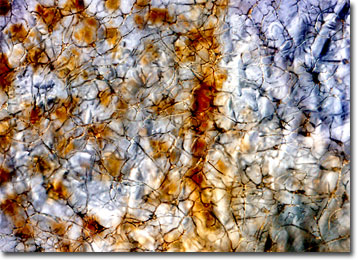Differential Interference Contrast Image Gallery
Cycloid Fish Scale
Extensions of the dermal layer of skin, fish scales provide their owners with some degree of protection from predators. Their composition and structure has altered over thousands of years through evolution, and today several different varieties of fish scales exist.

The primary types of fish scales include placoid, cosmoid, ganoid, ctenoid, and cycloid scales. Placoid scales, which consist of an outer layer of an enamel-like substance, an inner stratum of dentine, and a pulp cavity, are exhibited by sharks. Most primitive bony fish species, however, generally possess scales of ganoid or cosmoid type, which are thick and composed of several layers of bone, enamel, and related substances. Some advanced fishes also exhibit bony scales, but these typically allow more freedom of body movement than the earlier-evolved varieties. Thin, translucent, and lacking enamel as well as dentine, these modern structures are known as cycloid and ctenoid scales.
Both cycloid and ctenoid scales consist of a rigid surface layer primarily composed of calcium-based salts and a fibrous inner layer that is mainly made of collagen. The primary difference between the two types of scales is their fundamental shape. Cycloid scales exhibit a smoothly rounded posterior edge, whereas those of the ctenoid variety are characterized by a row of comb-like extensions. Both types line the skin in an overlapping design, but are generally associated with different aquatic species. Cycloid scales are most often found on carps and similar fishes, while ctenoid scales are more common to higher bony fishes, including perch and sunfish.
